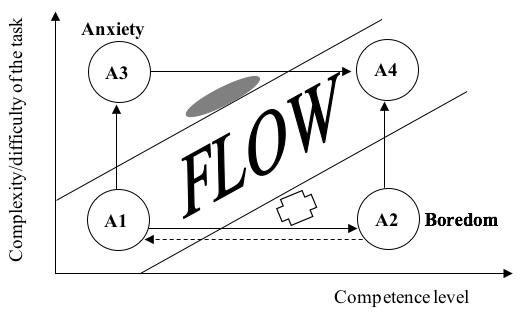Playing is the best stimulation for our brain
Did you ever feel guilty for playing too long or too much? Well, you should not... I'll tell you why if you read a little further.
Many neurophysiologists would agree that the Homo Sapiens (Wise Man) can as well be called Homo Ludens (Playing Man). Playing is essential or I would rather say inevitable part of our lives. Probably it is not only a coincidence that actors and musicians also „play” - we use the same word to address their performances and not without a reason: art has a lot to do with playing, actually it is the most sophisticated form of playing.
A healthy person is awake approximately 15-16 hours a day. We are obviously not concentrating on our past, present or future all this time, so there will be periods when we are „free” to do anything. Playing means freedom, and this is a function to „fill in” the idling of the nervous system.
Why can’t our brain just rest and relax during these periods?
Well, it cannot… Our nervous system gets into an aversive state if it lacks the necessary amount of activity while we are awake. We know this negative feeling very well: this is boredom that we often experience when we have nothing to do. Look at children waiting for something or animals at their idle periods: they all try to „fight” boredom with some sort of play. We, adults also often play, as this activity can make our life more „bearable”. We choose to play to stimulate our brain and fight boredom - we tell jokes, fill-in crosswords, play basketball with our friends, we all find the game suitable for us.
A game can give us pleasure. On a physiological level joy means the end of a preliminary inconvenient state. For example in case of eating the sequence is this: hunger – fulfilment – joy. Unlike these adaptive pleasures, the one gained from playing is faster, more intensive and more easily repeatable. Animals are also able to create this state. Just look at a cat playing with a mouse: lets it go after catching it, so that it can repeatedly experience the ecstasy of catching the prey again. The larger the inconvenience at the first phase, the greater the pleasure coming afterwards. Therefore all plays consist of different levels of this tension at the beginning, then the relief and the accompanying joy. Wow, one could say that it sounds like an addiction…. Though with more primitive forms of games (like gambling) it is a real danger that one can be addicted to it, but it rarely happens with more sophisticated versions, like chess for example.
When we are excited during playing, that is the only thing in our mind. We experience a so-called “flow” state. This is the state when our performance is the highest and when we are internally motivated to push our limits further and further. As Csíkszentmihályi – the leading researcher of the topic – claims it, we are all similar to an energy bomb during a flow state.
If you would like to experience it, it is important to set optimal goals, the challenge cannot be too high or too low. Here is a simple drawing I made to explain it:
When the difficulty of the task at hand matches our competence level, we can experience the flow. This can happen with relatively simple tasks, too (A1), but after a while, as our competence level is increasing, these become boring. When the task is too simple, we experience boredom: our brain does not get enough stimulation (A2). Then we can try to decrease our inconvenience by for example alcohol (this is the dotted line on the graph), but obviously, this is not a good solution, and works only in the short run. It is much better if we “raise the bar” with a greater challenge to get to state A4 where we can experience flow again.
Similarly, if the task at hand is too difficult and requires a higher level of competence that we have, we experience anxiety. The higher this, the worse is our performance, so this is not a convenient state, too. We have to practice in order to be able in flow again. Therefore the flow pushes us to achieve a little better all the time. We want to experience the joy again and again, so we try to stay in this state as long as possible.
The most exciting place is the grey area a little above the flow line. Many computer games or amusement park games, extreme sports belong to this zone. It is very entertaining to be in this state, as there is some level of uncertainty there. We can never know what is going to happen, there is a certain level of risk involved, which is exciting. The risk should not be too high, but some of it is necessary to keep interest. (How boring ball sports would be if one could score after each and every hit, kick or throw…)
Even animals know it. Just look at this video where monkeys are bullying two tiger cubs, this is pure flow that they might experience:
Source
If we are not able to make mistakes we can never get to this exciting zone. We bring this from our childhood. Children who were able to explore the environment and experiment will be able to accept reasonable risks as adults. But those who were overly protected will be “safe players” as adults. They do not dare to take risks, will always want to play safe, therefore can hardly experience flow, too. They close themselves in under the flow area (marked with a cross on the chart), near boredom. Life is not exciting if there is no uncertainty at all.
Considering what has been said about playing so far, we can conclude that playing is a protective mechanism for our brain (similarly to sleeping). The more we can play the less boredom we experience. Our brain needs stimulation and it is much better if we get this by games than by any other chemicals (like alcohol or drugs). So why don’t you dust that board game and play with your family? Or a good card game with friends? A puzzle to solve while you are waiting for the bus? It doesn’t matter what you play, just do something good for your brain!
Literature used
- Endre Grastyán (1983): A játék neurobiológiája (The neurobiology of playing), Akadémiai Kiadó, Budapest
- Mihály Csíkszentmihályi (2008): Flow: The Psychology of Optimal Experience, Harper Perennial Modern Classics, New York
Sources of pictures:
All pictures used in this post are public domain images (CC0 license) taken from the following sources:
1 Author: Leandro Ercole (a member of freeimages.com)
2 Author: Rodrigo Galindo (a member of freeimages.com)




Holy @#$%^! ... I have never seen such a simple graph explain so much about life. There are so many things I could think of that would prove your graph right, but I'll just highlight a few standouts...
This is definitely one of the most fascinating reads that I've found on Steemit. Now I do have one question I'd like to ask... you mention that the brain needs stimulation and cite games, alcohol, and drugs all as potential sources of that stimulation. Does that imply that because of this need for stimulation, every human is likely to end up with an addiction to something at some point during their lives, and why or why not?
Thanks a lot @doughtaker! :-)
Yes, I also like this simple chart, I use it quite often to explain for example the work-related fatigue that you just revealed.
Concerning your question... I would not put it that way. Well, our brain does need stimulation, and we tend to repeat those activities that give us pleasure and avoid the inconvenient ones. This MIGHT lead to addiction of any form, and yes, many end up doing something addictive. But the problem with addiction is the same that you explained with the games: after a while the same amount (of alcohol, nicotine, adrenaline etc.) is not enough... We need more and more to get rid of A2 state.
So the best is to try new things, collect exciting new experiences - not to lose our curiosity I would call. Looking for pure hedonistic pleasure without this curiosity can easily push us towards addiction...
I had to think it through for a bit, but your explanation makes sense. Thanks!
Thank you for your contribution. Dont forget to link references and sources when applicable!
=======================================================================================
This post was upvoted by Steemgridcoin with the aim of promoting discussions surrounding Gridcoin and science.
This service is free. You can learn more on how to help here.
Have a nice day. :)
Hey, thanks for the share. I love the part where you feature the chart of flow state. Super simple to understand.
Well, I do play mini mobile games form time to time, those that I know I won't get hooked for long, where I only go in for a few minutes and then I can get back to work. Yes, it does help in clearing the mind. But I try to stay away from RPGs because it's addictive!
Thanks a lot! Yes, I also love this chart, I often use it to describe why we got fed up with our job after doing the same routine every day... :-)))
Very informative.
Flow mighty word of the topic.
I regret playing less bcoz didn't knew the value of games than.
Thank you :-)
Great topic and even greater discovery (for me). I saw that chart and I thought "Wow I never looked at the correlation between boredom and anxiety before." Gotta stay in the flow zone but the gray area is a good place to be too haha
Yes, we need some excitement as well :-)))
So much informative and motivational
Graph is awesome and easy to understand
Also waiting for today’s challenge
Thank you 😊
Thank you!
This is the first time that I'm visiting your post and I must say that I'm not disappointed. Well done and keep up the good work. Have a nice day.